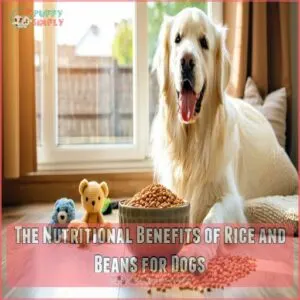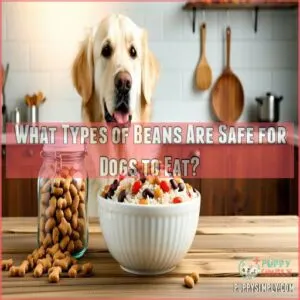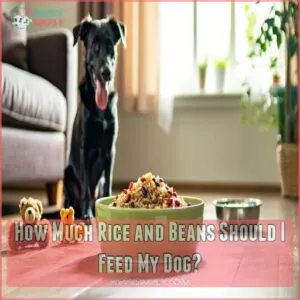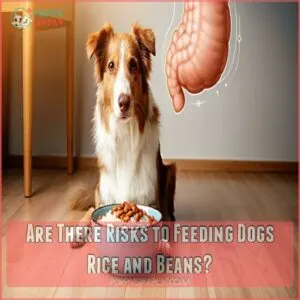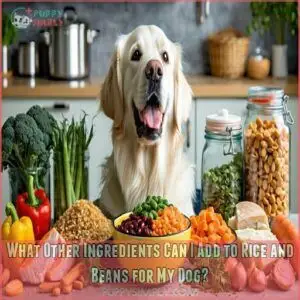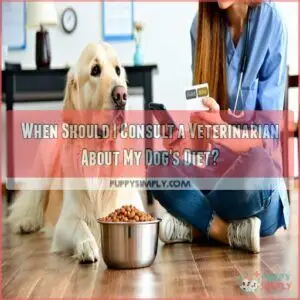This site is supported by our readers. We may earn a commission, at no cost to you, if you purchase through links.
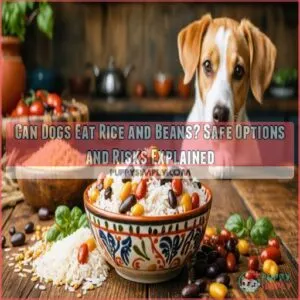 Yes, your dog can eat rice and beans as an occasional treat, but don’t let them go full foodie just yet!
Yes, your dog can eat rice and beans as an occasional treat, but don’t let them go full foodie just yet!
Cooked black beans, pinto beans, and garbanzo beans paired with plain rice can provide your pup with protein, fiber, and essential nutrients.
You’ll want to keep portions small – think of it as a side dish rather than the main course, making up no more than 10% of their daily calories.
Always cook these ingredients thoroughly without seasonings, and introduce them gradually to avoid any tummy troubles.
The right preparation method can make all the difference between a happy pup and an upset stomach.
Table Of Contents
- Key Takeaways
- The Nutritional Benefits of Rice and Beans for Dogs
- What Types of Beans Are Safe for Dogs to Eat?
- Can Dogs Digest Brown Rice?
- How Much Rice and Beans Should I Feed My Dog?
- Can Dogs Eat Basmati Rice and Beans?
- Are There Risks to Feeding Dogs Rice and Beans?
- Can Rice and Beans Be a Complete Meal for Dogs?
- How Should I Prepare Rice and Beans for My Dog?
- What Other Ingredients Can I Add to Rice and Beans for My Dog?
- When Should I Consult a Veterinarian About My Dog’s Diet?
- Frequently Asked Questions (FAQs)
- Conclusion
Key Takeaways
- You can feed your dog plain, cooked rice and beans in moderation, but they should make up no more than 10% of their daily calories.
- Stick to safe bean options like black beans, pinto beans, and garbanzo beans, and always cook them thoroughly without seasoning or added fats.
- Rice and beans are nutritious supplements but not a complete meal; your dog still needs a balanced diet with proteins, fats, and other essential nutrients.
- Watch for signs of allergies or digestive issues like gas and bloating, and consult your vet before making significant changes to your dog’s diet.
The Nutritional Benefits of Rice and Beans for Dogs
Rice and beans can be a great addition to your dog’s diet when prepared correctly. Rice offers an energy boost with its simple carbohydrates, while beans contribute protein, fiber, and essential nutrients such as calcium and vitamin D.
Brown rice, with its higher fiber content, supports digestive health, although white rice is easier to digest. Always keep it simple: no seasonings, fats, or extras.
Treat rice and beans as an occasional supplement for balanced nutrition, not the main course. For more information on dog nutritional needs, you should consult a veterinarian.
Done right, this combination packs valuable nutritional value!
What Types of Beans Are Safe for Dogs to Eat?
Many beans are both tasty and nutritious for your dog, but not all are safe.
Cooked black beans, pinto beans, and garbanzo beans are great options your pup can enjoy in moderation.
Black Beans
Black beans are one of the safe dog food beans packed with protein, fiber, and nutrients like potassium and iron. As a nutrient-rich option, they can support digestion and overall health.
When preparing black beans, always cook them thoroughly—raw or undercooked beans can upset your dog’s stomach. Keep the seasoning simple; no salt, butter, or spices.
While black beans are healthy for dogs, portion control is key. Overfeeding can cause gas or bloating, so stick to small amounts as an occasional treat. If you’re new to homemade dog food bean recipes, black beans are an easy and nutritious starting point.
For more information on dog food rice, to understand the nutritional value and potential risks associated with feeding rice to dogs is necessary.
Lima Beans
Lima beans are a fantastic addition to your dog’s diet, packed with fiber, protein, and valuable nutrients.
For dogs with allergies, lima beans contain phytic acid, which supports a stronger digestive system. These beans can promote better digestive health, thanks to their higher fiber content, making them ideal for soothing upset stomachs.
As a great carb source, they’re also suitable for overweight pups or sensitive stomachs. Always cook lima beans thoroughly—uncooked beans can upset your dog’s tummy. With moderation, lima beans are a win for canine nutrition!
Kidney Beans
Kidney beans are a safe treat for dogs when prepared correctly. Rich in protein, fiber, and nutrients, they can support your dog’s overall health. Just remember, preparation matters! Raw or undercooked kidney beans contain harmful lectins, so always cook them thoroughly.
Here’s what to keep in mind:
- Stick with plain, unsalted beans to avoid upsetting your pup’s stomach.
- Cook completely using pet-safe bean cooking methods like boiling.
- Moderate portions to guarantee balanced canine diet plans.
Adding kidney beans occasionally can be a great addition to your dog’s nutrition.
Pinto Beans
Pinto beans are a nutritious option your dog can enjoy, packed with fiber and essential nutrients that support canine health.
They’re a great plant-based source of protein, making them an easy addition to a balanced diet. Plus, their soft texture and mild taste make them appealing to most pups.
When dogs eat beans like pintos, it’s vital to guarantee proper bean preparation—cook them thoroughly and skip any seasonings.
Pinto benefits extend to supporting digestion, too, but always introduce them gradually to avoid stomach upsets or allergies. Bean nutrition plays a key role in complementing rice and beans for dogs.
Garbanzo Beans
Garbanzo beans, or chickpeas, are a healthy addition to your dog’s snack list. Packed with protein, fiber, and nutrients, they’re like tiny powerhouses for canine health. Think of them as a great choice for dogs needing a boost in digestion or energy.
When feeding garbanzo beans, make sure they’re plain, cooked, and served in moderation. Too much may upset their stomach. Never rely on garbanzo beans to replace a balanced diet.
- Benefits: High in nutrients for energy and digestion.
- Preparation: Cooked and unseasoned only.
- Caution: Watch for allergies or discomfort.
Can Dogs Digest Brown Rice?
Brown rice packs a punch in the area of canine nutrition, offering a boost of vitamins, minerals, and fiber.
The added fiber content can aid in digestion, but its bran layer makes it harder for some dogs to process. For pups with sensitive stomachs, white rice might be a better bet.
If you’re wondering, "Can dogs eat rice every day?" stick to moderation. Brown rice benefits your dog in small portions, supporting their overall health without risking potential rice allergies or digestive concerns.
How Much Rice and Beans Should I Feed My Dog?
When feeding your dog rice and beans, stick to about 10% of their daily caloric intake to maintain a healthy nutrient balance. Portion control is key, so adjust servings based on size and activity level.
Follow these steps for safe feeding:
- Introduce rice and beans gradually to avoid digestive issues.
- Divide meals into smaller portions throughout the day for steady energy.
- Consult your vet for precise calorie intake and meal frequency.
It is also vital to reflect on canine health when making dietary decisions for your pet. Remember, rice beans dog diets should complement, not replace, complete nutrition.
Can Dogs Eat Basmati Rice and Beans?
Absolutely, dogs can eat rice and beans, including basmati rice, as an occasional treat.
Basmati rice is a great option because it’s lower in calories and higher in fiber compared to other grains, making it a solid choice for your pet’s diet.
Its fiber content helps support digestion and keeps their calorie intake on track—perfect for dogs needing a bit of balance.
Understanding dog bean nutrition is vital for making informed decisions about their diet.
When preparing rice beans for a dog diet, always cook both thoroughly and avoid adding seasoning, butter, or oil.
Beans work as a low-calorie protein boost, but stick to safe ones like black beans or pinto beans.
Remember, these foods should only make up a small portion of their meals (no more than 10% daily).
A balanced diet remains key to meeting your dog’s nutrition needs.
Are There Risks to Feeding Dogs Rice and Beans?
While you can safely feed your dog rice and beans as an occasional treat, you’ll need to watch for potential issues like allergies, gas, and digestive problems.
Just like people who mightn’t tolerate certain foods well, your furry friend could experience bloating or tummy troubles if they eat too much of these fibrous foods.
Gas and Bloating
Many dogs can experience digestive issues when they first start eating rice and beans. Your pup’s gut needs time to adjust to these fiber-rich foods, which can initially cause gas and bloating.
Start with small portions – no more than 1 tablespoon per 10 pounds of body weight. If you notice stomach pain or unusual bowel health changes, try reducing the portion size.
For more information on dog food options, research is necessary. For better digestive health, cook both rice and beans thoroughly and serve them plain. Monitor your dog’s gut problems closely, and remember that canine rice and beans should only make up a small part of their diet.
Allergies
Your dog’s food allergies could make rice and beans a risky choice for their diet.
Just like humans, dogs can develop allergic reactions to grains and legumes, leading to skin issues and digestive discomfort.
Watch for signs of canine hypersensitivity, such as itching, redness, or swelling.
If you notice these symptoms, consider switching to hypoallergenic alternatives like quinoa or specialized protein sources.
Always introduce new foods gradually and monitor for dietary sensitivities.
Consulting your vet about your pup’s specific needs can help identify safe options that won’t trigger allergic reactions.
Digestive Issues
Beyond allergies, digestive issues can pop up when dogs eat rice and beans regularly. While these foods seem harmless, they can trigger stomach upset and affect your pup’s gastrointestinal health. Just like humans, dogs need specific enzymes to break down different foods properly.
Here’s what to watch for when feeding rice and beans:
- Irregular bowel movements or dog diarrhea
- Bloating and excessive gas
- Changes in appetite or energy levels
- Visible discomfort after meals
Think of your dog’s gut health like a finely-tuned engine – it needs the right fuel to run smoothly. Starting with small portions and monitoring their response helps prevent digestive troubles down the road, ensuring your dog’s overall stomach upset is minimized, and their appetite remains healthy.
Can Rice and Beans Be a Complete Meal for Dogs?
While rice and beans offer valuable nutrients, they shouldn’t be your dog’s only meal. Dogs need a balanced diet that includes specific proteins, fats, and vitamins that rice and beans alone can’t provide.
Here’s what you should know about canine health and balanced diets: For more information on dog food options, it’s essential to examine the nutritional value of each ingredient.
- Rice provides carbohydrates for energy but lacks essential amino acids
- Beans offer protein and fiber but miss vital fats dogs need
- Commercial dog food contains precisely measured nutrients for healthy health
- Meal planning should include rice and beans as supplements, not replacements
Consider rice and beans as healthy additions to your pup’s regular diet, not standalone meals.
How Should I Prepare Rice and Beans for My Dog?
Four simple steps guarantee your dog’s rice and beans are safe and nutritious. Start with plain, unseasoned ingredients to protect your pup’s digestion.
- Rinse rice thoroughly to remove excess starch and potential contaminants
- Cook rice in fresh water until soft, avoiding any seasonings or oils
- Soak dried beans overnight, then boil until completely tender
- Let both ingredients cool completely before serving
Always prepare rice and beans separately using basic cooking methods. This approach maximizes nutrient balance while making the meal easily digestible. For homemade dog food recipes using rice and beans, stick to white rice initially, as it’s gentler on their system. Utilizing dog food recipes can help create a well-rounded diet for your pet.
What Other Ingredients Can I Add to Rice and Beans for My Dog?
Looking to jazz up your dog’s rice and beans?
Beyond the basics, you can add lean proteins like cooked chicken, turkey, or fish for essential nutrients.
Mix in dog-friendly vegetables such as carrots, green beans, or pumpkin for extra fiber and vitamins.
A drizzle of healthy oils like fish oil or coconut oil can boost nutrition, while sweet potatoes offer complex carbs and fiber.
For homemade dog food recipes with rice and beans, consider adding plain yogurt for probiotics or eggs for protein.
It’s also key to understand dog food basics when preparing meals for your pet.
Just remember to introduce new ingredients gradually and keep portions moderate.
When Should I Consult a Veterinarian About My Dog’s Diet?
While adding healthy ingredients to your dog’s rice and beans is great, knowing when to seek veterinary guidance is equally important.
Watch for these warning signs that warrant a vet visit:
- Your dog skips meals for more than 24 hours
- You notice sudden changes in eating habits or excessive thirst
- Their stools become unusually hard, contain blood, or show signs of worms
- Unexplained weight loss occurs, even if they’re overweight
- They show persistent lethargy or unusual tiredness
Monitoring your dog’s health signs is essential for early detection of potential issues. If you’re planning significant dietary changes or suspect food allergies, schedule a check-up. Your vet can provide nutrition advice suited to your dog’s specific health conditions.
Frequently Asked Questions (FAQs)
Can dogs eat rice?
Like a warm bowl of comfort, rice is safe for your dog’s diet.
You can feed them plain, cooked white rice – it’s gentle on their stomach and provides energy.
Just keep portions modest.
Can one eat beans raw?
No, you shouldn’t eat raw beans as they contain toxins that can make you sick.
You’ll need to soak and thoroughly cook your beans until they’re tender to make them safe for consumption.
Can dogs eat dried beans?
Hard as rocks and tough on tummies, dried beans aren’t safe for your dog.
You’ll need to cook them thoroughly to remove harmful toxins and make them digestible for your furry friend’s tummies.
Can dogs eat baked beans?
You shouldn’t feed your dog baked beans.
They’re typically high in sugar, salt, and harmful seasonings like garlic and onions.
Plus, the tomato-based sauce commonly used in baked beans isn’t safe for dogs.
Can dogs eat kidney beans?
Dogs can eat kidney beans, but only if they’re thoroughly cooked.
Raw kidney beans contain lectin, a toxin harmful to dogs.
Keep them plain, unseasoned, and serve in moderation to avoid digestive upset or weight gain.
Are beans good for dogs?
Beans are a healthy treat for dogs when prepared correctly.
They’re packed with protein, fiber, and nutrients, but keep portions small, cook them thoroughly, and skip added seasonings to avoid digestive issues or toxic ingredients.
Can dogs eat cooked rice and beans?
Picture a cozy dinner plate—yes, you can share cooked, plain rice and beans with your pup.
Just make sure they’re unseasoned, served in moderation, and cooked thoroughly to avoid any tummy troubles.
Are beans ok for dogs to eat?
Yes, you can feed beans to dogs, but stick to cooked, plain varieties like green beans, black beans, or pinto beans.
Avoid seasoning, and always introduce them gradually to prevent digestive upset or gas.
Does rice stop diarrhea in dogs?
Worried rice mightn’t help?
Plain, cooked white rice can settle a dog’s upset stomach and firm up stools.
Its easy digestibility and low fiber content make it a great option for mild diarrhea relief.
How much rice can I give my dog?
Stick to about 1/4 to 1/2 cup of cooked rice for small dogs and up to 1 cup for larger breeds. Always balance it with protein and veggies to keep things healthy.
Conclusion
Ultimately, while rice and beans can make a tasty treat for your dog, they shouldn’t replace a balanced diet.
Stick to dog-safe options like black beans or pinto beans, pair them with plain rice, and serve in moderation.
Watch for signs of allergies or upset stomach, and always introduce new foods slowly, to ensure dog-safe options are truly safe, and this process contributes to a balanced diet.
Feeding rice and beans responsibly can provide some nutritional benefits, but consulting your vet guarantees you’re meeting your pup’s dietary needs without risks.
Keep their tail wagging!

